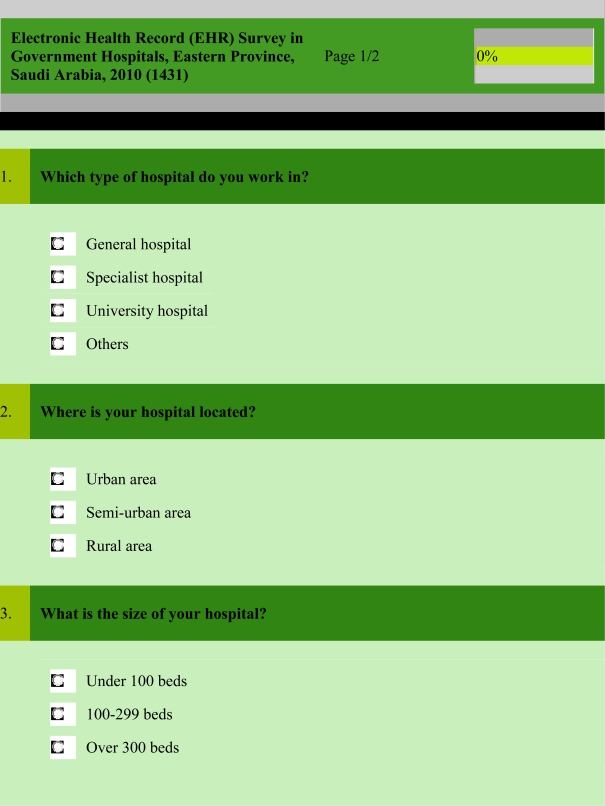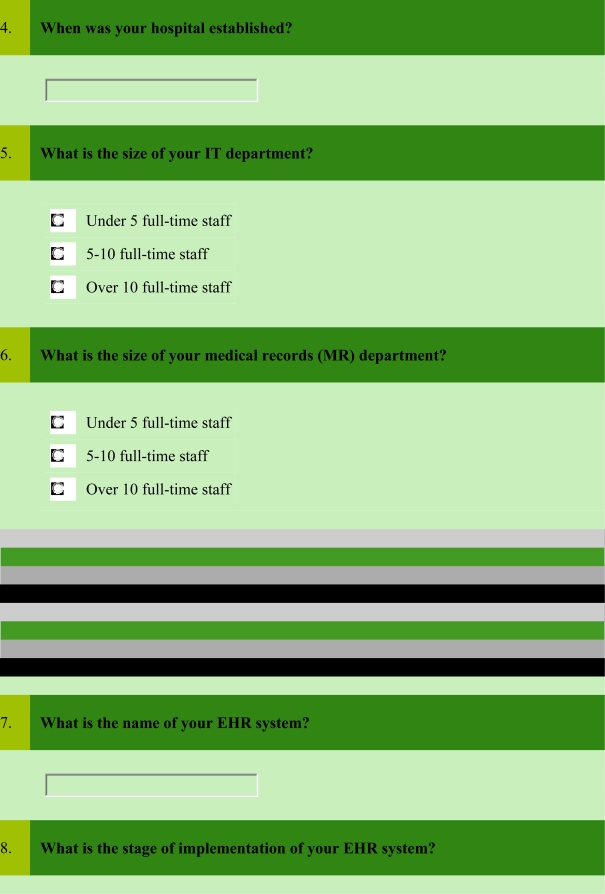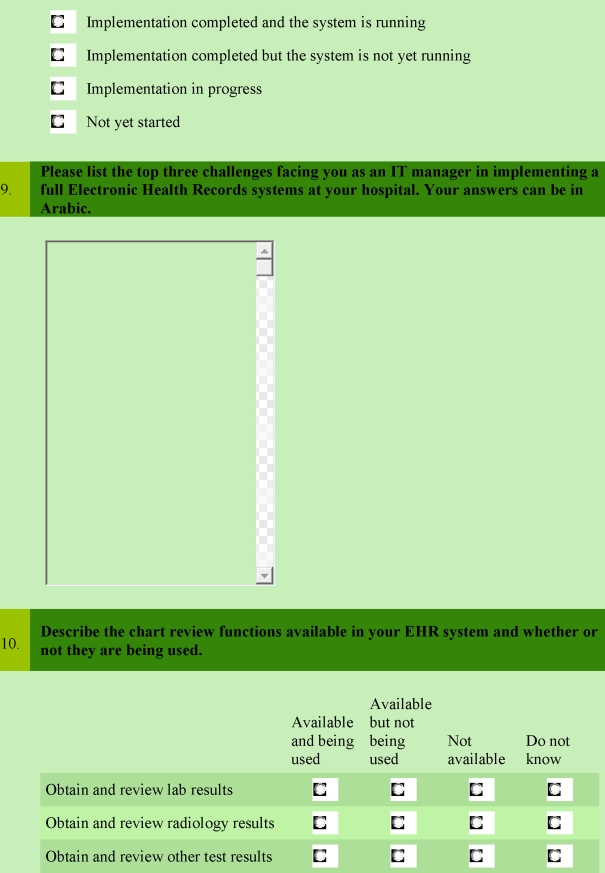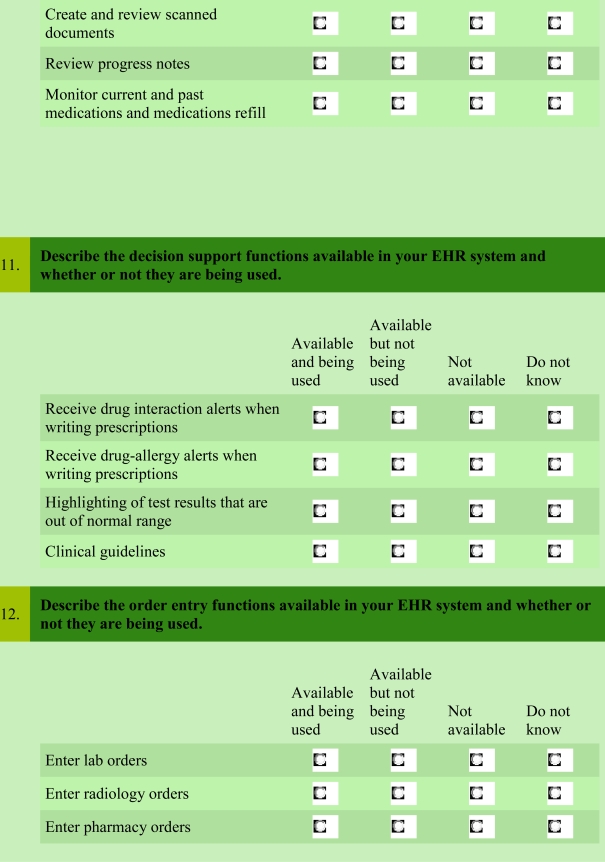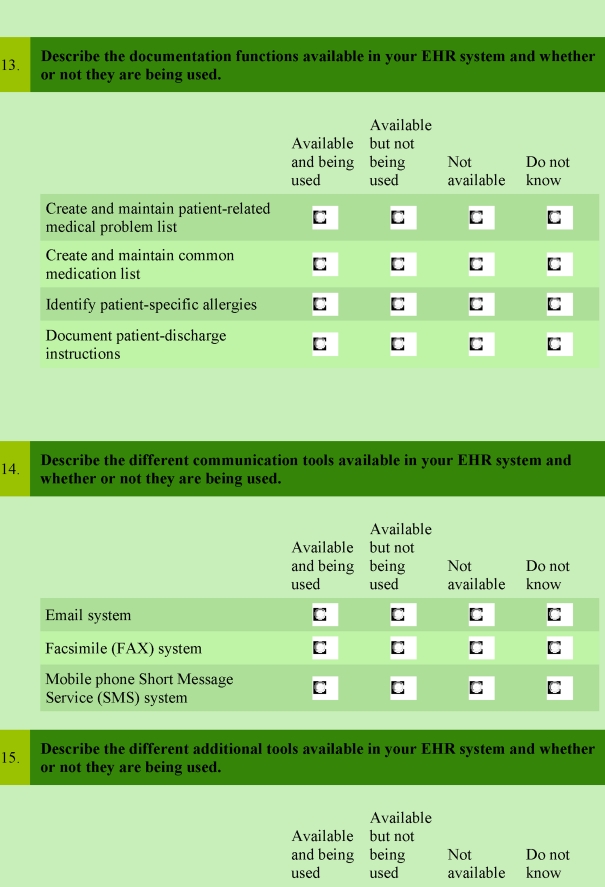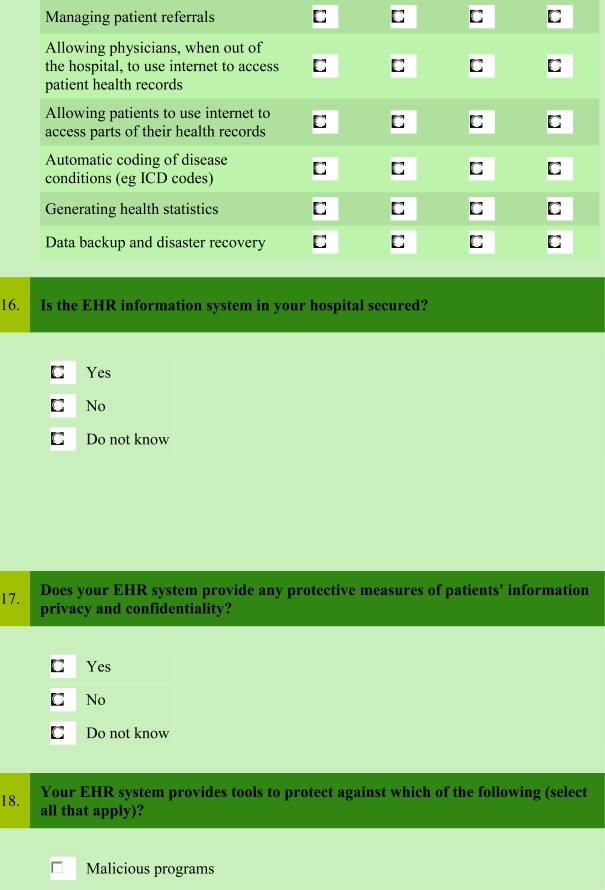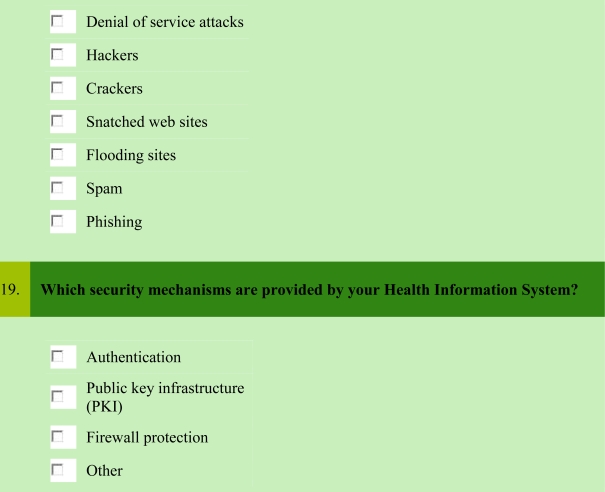Abstract
This study aims to determine the level and extent of usage of electronic health records (EHRs) in government-related hospitals in Eastern Province, Saudi Arabia. Another aim is to develop a Web site to serve as a forum of exchange on the development of EHRs in Saudi Arabia. All government hospitals (n = 19) in the province were included. The information technology (IT) managers in those hospitals made up the target population. An online questionnaire was developed, and the IT managers in all 19 government hospitals were invited to participate in the survey. The responses from the online survey were downloaded and analyzed using descriptive statistics. Of the 19 hospitals, only three (15.8 percent) use EHRs. These hospitals were established in 1984, 1995, and 2005. All three of these hospitals have implemented the same EHR software and were using it successfully, and all three were using the three core features of laboratory, radiology, and pharmacy electronic modules. Some modules were present in the EHR system but were underutilized. Some of the main challenges faced by the IT managers in implementing EHRs in their hospitals were related to the uncooperative attitudes of some physicians and nurses toward EHRs.
In fulfillment of the second aim of the study, a Web site, http://ehr2011.weebly.com, was developed to serve as a forum for exchange of information on the development of EHRs in Saudi Arabia. The government of Saudi Arabia has prioritized the development of eHealth (health information technology) and allocated committed funding for it during 2008–2011. During this period, some sectors of government made highly commendable efforts in developing eHealth services. Along these lines, we had hoped to see higher uptake of EHRs than the 15.8 percent found in this study. The rate of implementing EHRs in government hospitals should be accelerated. The aim should be on achieving some basic EHR functionality in these hospitals, and once this has been achieved, additional functionality can be pursued in stages.
Key words: electronic health record, Saudi Arabia
Introduction
The government of Saudi Arabia has prioritized the development of eHealth (health information technology) and allocated committed funding for it during 2008–2011. During this period, some sectors of government made highly commendable efforts in developing eHealth services. Because what cannot be measured cannot be improved, it is necessary to measure the level and extent of usage of electronic health records (EHRs) and monitor the improvement over time. This study aims to measure the level and extent of usage of EHRs in government-related hospitals (n = 19) in Eastern Province, Saudi Arabia.
Background
EHRs are known by a multitude of names, including electronic medical records (EMRs) and computer-based patient record (CBPRs). One definition of the EHR is the following:
The Electronic Health Record (EHR) is a longitudinal electronic record of patient health information generated by one or more encounters in any care delivery setting. Included in this information are patient demographics, progress notes, problems, medications, vital signs, past medical history, immunizations, laboratory data and radiology reports. The EHR automates and streamlines the clinician's workflow. The EHR has the ability to generate a complete record of a clinical patient encounter—as well as supporting other care-related activities directly or indirectly via interface—including evidence-based decision support, quality management, and outcomes reporting.1
The literature gives many advantages for adopting EHR systems. One is the reduction of costs achieved through the reduction in duplication of services and the reduction in the number of personnel through computerization of manual services and automation of coding.2 EHRs improve quality of care due to diminished medical errors by providing healthcare workers with decision support systems. They also promote evidence-based medicine by providing access to unprecedented amounts of clinical data for research that can increase the level of knowledge of effective medical practices.3 Further, EHRs improve the efficiency and effectiveness with which patient care services are delivered by clinicians. They allow for simultaneous remote access to patient data, legibility of records, safer data storage, patient data confidentiality, flexible data layouts, and continuous data processing.4–7 EHRs are more reliable due to the presence of a good backup system for disaster recovery. Patient satisfaction is enhanced through the smooth handling of referrals, reduction of the need for multiple tests, ease in accessing results, and detection of serious health threats that may be life threatening.8 For these and other reasons, EHR use has been prioritized in many countries and is seen as the future in healthcare delivery.
Two kinds of surveys are undertaken in order to measure the level and extent of EHR usage. One is done at the hospital level, and the other is done at the physician level. The former aims to look at the uptake of EHR among hospitals in general, while the latter explores the extent to which physicians make use of EHR systems in their practices or in hospitals. Hospital-based surveys answer questions about the diffusion of uptake of EHR systems in hospitals. Are hospitals moving toward EHR adoption? Are hospitals advancing in the level of EHR usage?9 Physician-based surveys answer question about the resistance or acceptance of physicians in adopting EHR systems, the components of EHR systems that physicians use the most, and the profile of physicians most likely to use EHRs.10–12 It is logical to start with hospital-based EHR surveys before embarking on physician-based ones.
Results from hospital-based EHR surveys are often presented in one of two ways. The first is to use simple percentages to show the level of availability and usability of the different dimensions of EHR adoption. Year-to-year comparison of these percentages helps in assessing improvement in EHR uptake. This is the approach used by the Medical Records Institute in the United States.13 The second approach is to put these percentages into a model to deduce the “stage” of EHR adoption and its “score.” This approach helps in international comparison of EHR adoption and is used by the Healthcare Information Management and Systems Society in their Electronic Medical Record Adoption Model.14
As in the case of developed countries, Saudi Arabia has prioritized the development of eHealth and, along with it, the transition from paper-based health records to EHRs. The Saudi government adopted the following mission for eHealth: “A safe quality healthcare system based on patient centric care guided by standards, enabled by eHealth.”15 The Ministry of Health allocated a total of 4 billion Saudi riyal ($1.07 billion in U.S. dollars) toward eHealth programs for the four-year period from 2008 to 2011.16 An eHealth plan has been put together that integrates with the plans of the Ministry of Health. Some institutions are now well advanced in their implementation of eHealth. The best example of this is the National Guard Health Affairs (NGHA). This institution is now using EHRs, and all of its hospitals are integrated together.17
Little is known about the level of computerization in Saudi government hospitals falling under the Ministry of Health. Much less is known about their adoption of EHRs. According to Altuwaijri (2008), the IT infrastructure is poor in the Ministry of Health hospitals.18 Our literature search did not find any studies on EHR uptake in Saudi Arabia. As EHR use has been prioritized by the Saudi government, it is important that its uptake be measured and monitored.
Objective
The primary objective of the study is to determine the level and extent of usage of EHRs in government-related hospitals in Eastern Province, Saudi Arabia. At the time of the study (2010), the total number of government hospitals was 19, and all of them were included in the study. Another objective was to develop a Web site to serve as a forum of exchange on the development of EHRs in Saudi Arabia.
Methodology
Data Collection
A cross-sectional questionnaire-based survey was used, and the respondents in the study were the heads of the information technology (IT) departments in the different government hospitals. As these individuals are all computer literate, it was decided to make the survey a Web-based one. The survey was conducted online from November 2010 to December 2010.
The questionnaire for the study was developed in stages. The Web survey software 2ask was used to develop the questionnaire (https://secure-0004.2ask.net). In the first stage, several questionnaires used in the literature were adapted and used to produce a draft for the survey.19, 20 The project committee met, discussed the draft, and produced a second draft. The Web survey was pilot-tested on members of the project committee, and comments were used to improve on the questionnaire. Revisions and refinements were made until a final draft was produced. Hence the final draft was based on several questionnaires and input from project committee members. See the Appendix for the final questionnaire as it appears in 2ask.
The questionnaire covered different EHR topics. Background questions asked about the type, size, location, and year of establishment of the hospital. Further questions asked about the different functionalities of the EHR system, chart review, decision support, order entry, documentation, and communication. Several questions asked about the security of the EHR system. A general question asked about the additional tools present in the EHR system. An open-ended question asked about the problems that the IT heads faced in implementing EHRs in their hospitals.
Since the survey was to be done in government hospitals, permission was sought from the Ministry of Health to conduct the survey. The permission was granted, and the main contact person at the Ministry of Health in Riyadh offered to assist in getting the IT heads to participate in the survey.
The usual procedure in carrying out a Web-based survey is to collect the e-mail addresses of the recipients and send them a hyperlink to the online questionnaire for completion. In this case, the hyperlink was sent only to the contact person at the Ministry of Health, who forwarded it to all the IT heads. The contact person also reminded the IT heads to complete the survey when there was delay in responding. The survey was closed to further responses in December 2010, and the data was subsequently downloaded for analysis.
Analysis
As the number of participants was few, the analysis is mostly descriptive. The data cannot allow for statistical comparison between groups.
Results
In total, there are 19 government hospitals in the Eastern Province that fall under the Ministry of Health. Of these, only three (15.8 percent) have EHRs. These hospitals were established on different dates, each about 10 years apart, in 1984, 1995, and 2005. One of the hospitals is located in an urban area; the second, in a semi-urban area; and the third, in a rural area. Of the three hospitals, two have more than 300 beds and one has a bed capacity between 100 and 299 beds. Two of the three hospitals have more than 10 full-time IT staff members, while one has less than five full-time IT staff. All three hospitals have implemented the same EHR software and were using it successfully. In addition, these three hospitals have less than five full-time staff in their medical record department.
Table 1 shows the results for questions 10 to 15, showing the level of availability and usability of the different EHR functions. Regarding the chart review functions of their EHR system, all three IT heads mentioned that their hospitals use the EHR system to obtain and review lab results, progress notes, and radiology results. Their EHR system can also monitor current and past medications and medication refills, but they mentioned that their EHR system does not have a function by which they can create and review scanned documents. Two of the IT heads indicated that their hospitals are using the EHR system to obtain and review other test results, and one respondent confirmed that the EHR system has the function to obtain and review other test results but this function is not being used in that hospital.
Table 1.
Availability and Usability of Functions of the EHR System at Government Hospitals in Eastern Province, Saudi Arabia (n = 19)
| Category | Function | Available and Being Used | Available But Not Being Used | Not Available | Do Not Know |
|---|---|---|---|---|---|
| Chart review | Obtain and review lab results |
15.8% |
0.0% |
84.2% |
0.0% |
| Obtain and review radiology results |
15.8% |
0.0% |
84.2% |
0.0% |
|
| Obtain and review other test results |
10.5% |
5.3% |
84.2% |
0.0% |
|
| Create and review scanned documents |
0.0% |
0.0% |
100.0% |
0.0% |
|
| Review progress notes |
15.8% |
0.0% |
84.2% |
0.0% |
|
| Monitor current and past medications and medication refills | 15.8% | 0.0% | 84.2% | 0.0% | |
| Decision support | Receive drug interaction alerts when writing prescriptions |
15.8% |
0.0% |
84.2% |
0.0% |
| Receive drug allergy alerts when writing prescriptions |
15.8% |
0.0% |
84.2% |
0.0% |
|
| Highlight test results that are out of normal range |
15.8% |
0.0% |
84.2% |
0.0% |
|
| Clinical guidelines | 15.8% | 0.0% | 84.2% | 0.0% | |
| Order entry | Enter lab orders |
15.8% |
0.0% |
84.2% |
0.0% |
| Enter radiology orders |
15.8% |
0.0% |
84.2% |
0.0% |
|
| Enter pharmacy orders | 15.8% | 0.0% | 84.2% | 0.0% | |
| Documentation | Create and maintain patient-related medical problem list |
15.8% |
0.0% |
84.2% |
0.0% |
| Create and maintain common medication list |
15.8% |
0.0% |
84.2% |
0.0% |
|
| Identify patient-specific allergies |
15.8% |
0.0% |
84.2% |
0.0% |
|
| Document patientdischarge instructions | 15.8% | 0.0% | 84.2% | 0.0% | |
| Communication | E-mail |
0.0% |
0.0% |
100.0% |
0.0% |
| Facsimile (fax) |
0.0% |
0.0% |
100.0% |
0.0% |
|
| Mobile phone short message service (SMS) system | 0.0% | 15.8% | 84.2% | 0.0% | |
| Additional tools | Managing patient referrals |
10.5% |
5.3% |
84.2% |
0.0% |
| Allowing physicians, when out of the hospital, to use the Internet to access patient health records |
0.0% |
15.8% |
84.2% |
0.0% |
|
| Allowing patients to use the Internet to access parts of their health records |
0.0% |
15.8% |
84.2% |
0.0% |
|
| Automatic coding of disease conditions (e.g., ICD codes) |
15.8% |
0.0% |
84.2% |
0.0% |
|
| Generating health statistics |
15.8% |
0.0% |
84.2% |
0.0% |
|
| Data backup and disaster recovery | 15.8% | 0.0% | 84.2% | 0.0% | |
When asked about decision support functions of their EHR system, all three IT heads agreed that the EHR systems of their hospitals were equipped with decision support functions, and they are using these functions to receive drug interaction and drug allergy alerts when writing prescriptions and to highlight test results that are out of normal range.
Regarding the order entry functions of their EHR system, all three IT heads agreed that the EHR system used in their hospital has order entry functions, and they are using these functions to enter lab, radiology, and pharmacy orders.
When asked about documentation functions of the EHR system used in their respective hospitals, all three respondents agreed that the EHR system was equipped with documentation functions, and they are using these functions to create and maintain lists of common medication and patient-related medical problems, to identify patient-specific allergies, and to document patient-discharge instructions.
Regarding the communication tools of their EHR system, all three respondents indicated that the EHR system used in their hospital does not have e-mail and fax functions. The system does have a mobile phone short message service (SMS) function, but they did not make use of this function.
About the additional tools available in the EHR systems being used in their hospitals, two respondents agreed that their EHR system has a facility by which they can manage patient referrals, and they indicated that they are using this facility. On the other hand, one respondent confirmed that his hospital's EHR system has a facility by which he can manage patient referrals, but he is not using this facility. The respondents also mentioned that their EHR system allows for physicians using the Internet to access patient health records as well as for patients using the Internet to access parts of their health records. However, all three said that they are not using this facility. All three respondents mentioned that their EHR system has facilities for automatic coding of disease conditions, generating health statistics for patients, and performing data backup and disaster recovery, and they indicated that they are using all of these facilities.
Regarding the security measures of their EHR information system, one respondent (from the hospital established in 2005) stated that his EHR information system was secured and provided protective measures regarding the privacy and confidentiality of patients' information. However, the two remaining respondents were not able to comment on these topics. Also, one respondent (from the hospital established in 2005) mentioned that the EHR system used in his hospital provides protection against malicious programs, denial-of-service attacks, hackers, crackers, and spam. The remaining two respondents indicated that their EHR system provides protection only against hackers and spam.
Regarding the security mechanisms provided by their EHR systems, none of the respondents reported using authentication, public key infrastructure (PKI), or firewall protection. However, they mentioned that they use “other” mechanisms for security of their EHR system.
When asked about the top three challenges facing them as IT managers in implementing a full EHR system at their hospitals, two of the respondents indicated the “lack of seriousness of the doctors in inserting a prescription” as biggest challenge facing them, and one respondent mentioned the “unwillingness of doctors in the introduction of electronic medical prescription” as the biggest challenge.
Respondents were asked one open-ended question on prioritizing the problems or challenges they were facing in implementing EHRs in their hospitals. In response to this question, two respondents identified the “lack of seriousness of the nursing staff about introduction of progress note” as the second biggest challenge, and one respondent identified “nursing staff tries not to abide by typing progress note” as the second biggest challenge. Two of the respondents reported that the “unwillingness of doctors to write the initial diagnosis of patient's condition” was the third biggest challenge facing them, while one respondent indicated that the “lack of seriousness of the doctor in the introduction of the initial diagnosis of the patient” was the third biggest challenge.
In fulfillment of the second aim of the study, a Web site was developed to serve as a forum of exchange on the development of EHRs in Saudi Arabia. The Web site address is http://ehr2011.weebly.com.
Discussion
A surprising finding in this study is that only three out of 19 Ministry of Health hospitals in the Eastern Province have implemented EHRs. This makes the level of EHR uptake in the province 15.8 percent. Partly because of the centralization at the Ministry of Health, all these hospitals are using the same EHR system. For this reason, the EHR functionalities used in these hospitals are largely similar. All of them use the three core features of laboratory, radiology, and pharmacy electronic modules. We found some modules that were present in the EHR system but were underutilized. An example is the module dealing with out-of-hospital Internet access of records by either physicians or patients. This underutilization is possibly related to security issues. If an EHR system is not secure enough, then there could be restrictions in accessing it through the Internet. This suspicion is supported by the fact that two of the three respondents did not know how secure their EHR system was. Another possible reason has to do with the workload of physicians. If physicians have heavy workloads, they will not be easily motivated to attempt to access patients' medical records from home via the Internet. Another possible reason for the underuse of this feature has to do with the minimal cultural valuation of patients' rights and low degree of patient empowerment. If patients were sufficiently informed about their rights and were empowered, they would request to have access to parts of their health records and their requests would be granted.
The study found the hospital established in 2005 to be more security conscious than the ones built earlier. Since all the hospitals are government hospitals and use the same EHR system, we suspect that this has to do with differences between the IT managers. An IT manager who is more knowledgeable about security issues will take extra measures to enhance the security of health records, even beyond what is available within the EHR system.
Conclusions
The development of eHealth is related to many factors: the level of development in the country, the level of IT usage, the level of education, the willingness to apply IT solutions to everyday problems, the awareness about quality and the need to improve it, and the respect for timely information. To a large extent, most of these conditions are present in Saudi Arabia; hence we see a strong commitment to the development of eHealth. It is timely that this study is taking place at the end of the above-mentioned four-year period (2008–2011) during which eHealth development has received committed funding. In line with the highly commendable eHealth efforts taking place in the National Guards Health Affairs (NGHA) and the Armed Forces of Saudi Arabia, for example, we would like to see higher uptake of EHRs in the Eastern Province than the 15.8 percent found in this study. The commitment of the Ministry of Health toward eHealth should translate into higher levels of EHR uptake in the government hospitals.
We see this study as the beginning of a bigger project to measure the level and usability of EHRs for all hospitals in Saudi Arabia, public as well as private. Another surprising result found after completion of this study is the fact that another major hospital in the Eastern Province has used the EHR system; however, its level of usage needs further in-depth investigation. One shortcoming of the study is the lack of direct access to all the IT managers of government-related hospitals. Having direct access to respondents is much preferable to having indirect access to them.
Recommendations from this Study
The authors offer the following recommendations for eHealth in Saudi Arabia based on this study:
The rate of implementing EHRs in government hospitals should be accelerated. The aim should be on achieving some basic EHR functionality in these hospitals. Once this has been achieved, additional functionality can be pursued in stages.
There are currently more than 300 EHR software tools on the market. If EHR systems are going to be installed in all government hospitals, research should be done on which EHR system gives the best value for the money, paying attention to those EHR systems that have international recognition.
Related to the second point above, the current EHR system being used should be evaluated to assess its continued suitability in the light of other competing EHR systems.
Physicians and nurses should be trained on the importance of EHRs and the importance of adding progress notes to the EHR.
For relevance beyond Saudi Arabia, this online survey can be used for evaluation of EHR use in other countries and regions (all IT managers are expected to have Internet access).
To measure the extent of EHR adoption over time, the survey should be repeated nationally at regular intervals (every two years, three years, etc.).
The research is applicable to other regions both nationally and internationally. Specifically, the kingdom of Saudi Arabia is divided into many provinces; this study could be conducted in other provinces, such as the central province, which includes the capital (Riyadh) and other surrounding cities, and the western provinces that include Makkah, Madinah, Jeddah, and other surrounding cities. This should help us better understand the level of adoption among other provinces and factors affecting such adoption.
Acknowledgment
These project achievements could not have happened without the support of Dr. Mohammed Alyemeni, advisor to the Minister of Health as well as engineer Hamad Almatroody, IT director for the Ministry of Health in Eastern Province, Saudi Arabia.
Appendix
Final Version of the Electronic Health Record (EHR) Survey Questionnaire
Contributor Information
Sulaiman Bah, Sulaiman Bah, PhD, MA, MPhil, is a professor at the College of Applied Medical Sciencesat the University of Dammam in Saudi Arabia..
Hana Alharthi, Hana Alharthi, PhD, is a assistant professor at the College of Applied Medical Sciences at the University of Dammam in Saudi Arabia..
Azza Ali El Mahalli, Azza Ali El Mahalli, MD, PhD, is an associate professor of health administration and planning at the College of Applied Medical Sciences at the University of Dammam in Saudi Arabia and the High Institute of Public Health, Alexandria University in Egypt..
Abdelkaream Jabali, Abdelkaream Jabali, PhD, is an associate professor at the College of Applied Medical Sciences at the University of Dammam in Saudi Arabia..
Mona Al-Qahtani, Mona Al-Qahtani, PhD, is an associate professor at the College of Applied Medical Sciences at the University of Dammam in Saudi Arabia..
Nouf Al-kahtani, Nouf Al-kahtani PhD, is the Vice Dean for E-Learning, Deanship of E-Learning and Distance Education at the University of Dammam in Saudi Arabia..
Notes
- 1.Healthcare Information and Management Systems Society (HIMSS). EHR: Electronic Health Record. Available at http://www.himss.org/ASP/topics_ehr.asp
- 2.Greenhalgh T, Stramer K, Bratan T, Byrne E, Russell J, Potts H.W. “Adoption and Non-adoption of a Shared Electronic Summary Care Record in England: A Mixed-Method Case Study.”. British Medical Journal. 2010;340:c3111. doi: 10.1136/bmj.c3111. [DOI] [PubMed] [Google Scholar]
- 3.Hoffman S, Podgurski A. “Finding a Cure: The Case for Regulation and Oversight of Electronic Health Record Systems.”. Harvard Journal of Law and Technology 22. 2008;(no. 1):107. Available at http://jolt.law.harvard.edu/articles/pdf/v22/22HarvJLTech103.pdf. [Google Scholar]
- 4.Van Fleet, DV. “How New Technologies Will Affect Health Care Managers.” AllBusiness.com. April 22, 2010. Available at http://www.allbusiness.com/health-care/healthcare-overview/14322859-1.html
- 5.Sittig, D. “Advantages of Computer-based Medical Records.” The Informatics Review. 1999. Available at http://www.informatics-review.com/thoughts/advantages.html
- 6.Beverly, A. “Paper vs. Electronic Medical Records.” eHow.com. Available at http://www.ehow.com/facts_6174214_paper-vs_-electronic-medical-records.html
- 7.Mole D.J, Fox C, Napolitano G. “Electronic Patient Data Confidentiality Practices among Surgical Trainees: Questionnaire Study.”. Annals of the Royal College of Surgeons of England 88. 2006;(no. 6):550–53. doi: 10.1308/003588406X117089. Available at http://www.ncbi.nlm.nih.gov/pmc/articles/PMC1963756/. [DOI] [PMC free article] [PubMed] [Google Scholar]
- 8.Sittig, D. “Advantages of Computer-based Medical Records.”
- 9.Jha A, DesRoches C, Campbell E, et al. “Use of Electronic Health Records in U.S. Hospitals.”. New England Journal of Medicine. 2009;360:1628–38. doi: 10.1056/NEJMsa0900592. [DOI] [PubMed] [Google Scholar]
- 10.Laerum H, Ellingsen G, Faxvaag A. “Doctors' Use of Electronic Medical Records Systems in Hospitals: Cross Sectional Survey.”. British Medical Journal. 2001;323:1344–48. doi: 10.1136/bmj.323.7325.1344. [DOI] [PMC free article] [PubMed] [Google Scholar]
- 11.Burt C, Sisk J. “Which Physicians and Practices Are Using Electronic Medical Records?”. Health Affairs 24. 2005;(no. 5):1334–43. doi: 10.1377/hlthaff.24.5.1334. [DOI] [PubMed] [Google Scholar]
- 12.Edsall R, Adler K. “User Satisfaction with EHRs: Report of a Survey of 422 Family Physicians.”. Family Practice Management 15. 2008;(no. 2):25–32. [PubMed] [Google Scholar]
- 13.Medical Records Institute. Medical Records Institute's Seventh Annual Survey of Electronic Health Record Trends and Usage for 2005. Boston: Medical Records Institute, 2005. Available at http://www.ehto.org/2006/US%20Medical%20Records%20Institute%20-%20Results%20of%20the%20EHR%20global%20survey%20in%202005.pdf
- 14.Healthcare Information and Management Systems Society. EMR Adoption Model. Available at http://www.himssanalytics.org/stagesGraph.asp
- 15.Alyemeni, M. Five Year Program to Transform Healthcare Delivery in Saudi Arabia. Saudi Arabia Ministry of Health. Available at http://www.himss.org/content/files/MiddleEast10_presentations/CS1_MohammedAlYemeni.pdf
- 16.Qurban, M., and R. Austria. “Public Perception on E-Health Services: Implications of Preliminary Findings of the King Fahd Military Medical Complex for Military Hospitals in the Kingdom of Saudi Arabia.” Presented at the European and Mediterranean Conference on Information Systems (EMCIS), Dubai, May 25–26, 2008.
- 17.QuadraMed. “Saudi Arabia Health Care System Receives Coveted ‘Excellence in Electronic Health Records’ Award with QuadraMed's EHR Solution.” March 30, 2010. Available at http://quadramed.com/getattachment/67cd3097-3a52-41ac-88a1-03b7553f2435/2010-3-30.aspx
- 18.Altuwaijri M.M. “Electronic-health in Saudi Arabia: Just Around the Corner? Saudi Medical Journal 29. 2008;(no. 2):171–78. [PubMed] [Google Scholar]
- 19.Canada Health Infoway. System and Use Assessment Survey. Available at http://healthit.ahrq.gov/portal/server.pt/gateway/PTARGS_0_1248_811831_0_0_18/Canada_Health_Infoway_SAU.doc
- 20.American Academy of Family Physicians. FPM Electronic Health Record (EHR) User-Satisfaction Survey-2007. Available at http://www.aafp.org/fpm/2007/0400/fpm20070400p27-rt1.pdf



